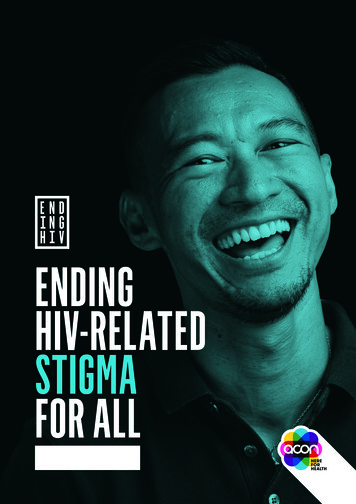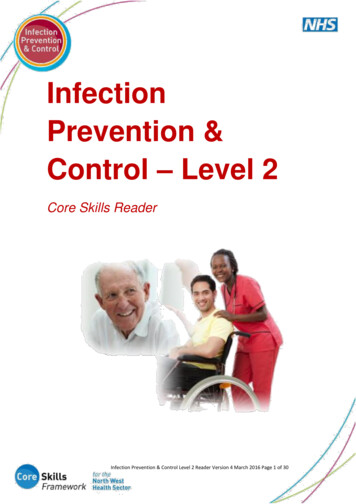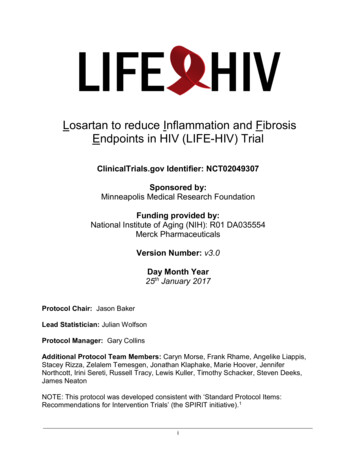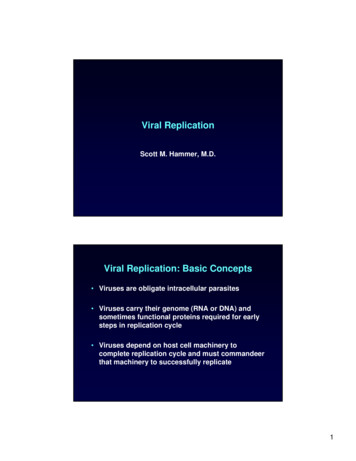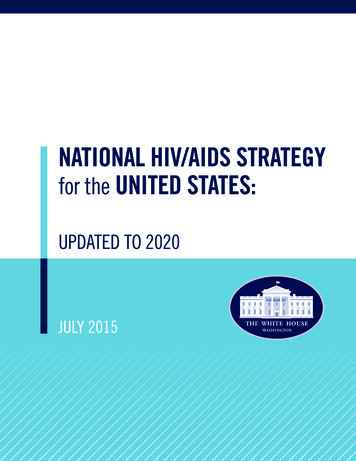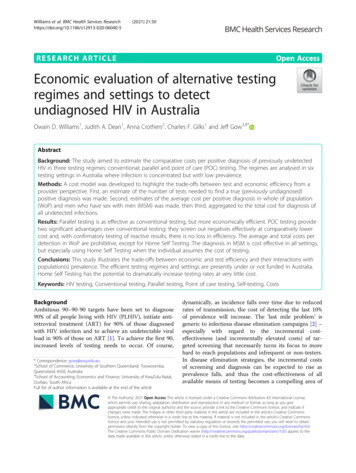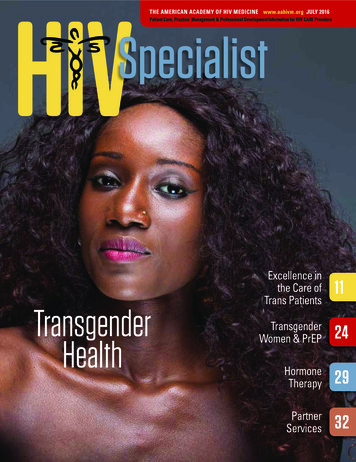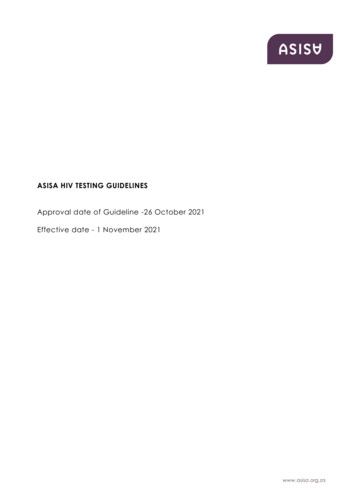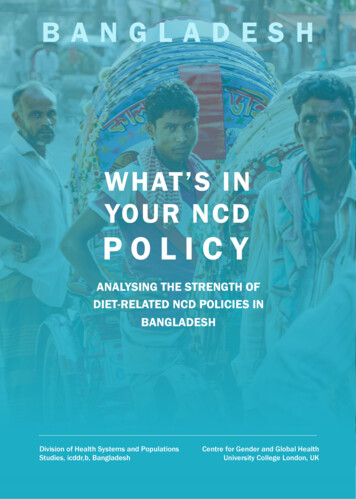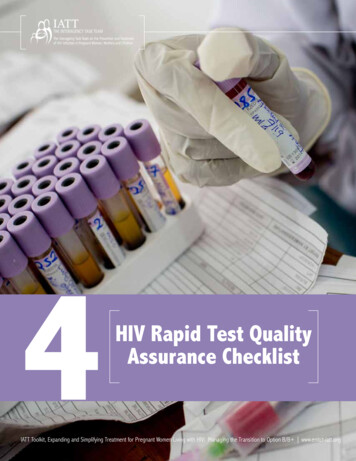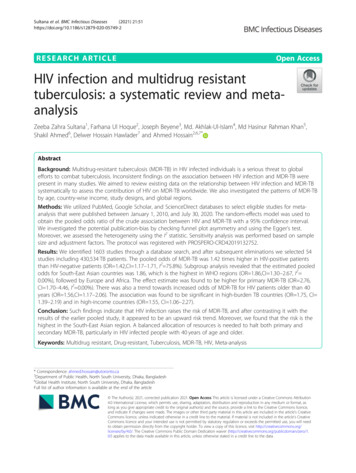
Transcription
Sultana et al. BMC Infectious Diseases(2021) EARCH ARTICLEOpen AccessHIV infection and multidrug resistanttuberculosis: a systematic review and metaanalysisZeeba Zahra Sultana1, Farhana Ul Hoque2, Joseph Beyene3, Md. Akhlak-Ul-Islam4, Md Hasinur Rahman Khan5,Shakil Ahmed6, Delwer Hossain Hawlader7 and Ahmed Hossain2,6,7*AbstractBackground: Multidrug-resistant tuberculosis (MDR-TB) in HIV infected individuals is a serious threat to globalefforts to combat tuberculosis. Inconsistent findings on the association between HIV infection and MDR-TB werepresent in many studies. We aimed to review existing data on the relationship between HIV infection and MDR-TBsystematically to assess the contribution of HIV on MDR-TB worldwide. We also investigated the patterns of MDR-TBby age, country-wise income, study designs, and global regions.Methods: We utilized PubMed, Google Scholar, and ScienceDirect databases to select eligible studies for metaanalysis that were published between January 1, 2010, and July 30, 2020. The random-effects model was used toobtain the pooled odds ratio of the crude association between HIV and MDR-TB with a 95% confidence interval.We investigated the potential publication-bias by checking funnel plot asymmetry and using the Egger’s test.Moreover, we assessed the heterogeneity using the I2 statistic. Sensitivity analysis was performed based on samplesize and adjustment factors. The protocol was registered with PROSPERO-CRD42019132752.Results: We identified 1603 studies through a database search, and after subsequent eliminations we selected 54studies including 430,534 TB patients. The pooled odds of MDR-TB was 1.42 times higher in HIV-positive patientsthan HIV-negative patients (OR 1.42,CI 1.17–1.71, I2 75.8%). Subgroup analysis revealed that the estimated pooledodds for South-East Asian countries was 1.86, which is the highest in WHO regions (OR 1.86,CI 1.30–2.67, I2 0.00%), followed by Europe and Africa. The effect estimate was found to be higher for primary MDR-TB (OR 2.76,CI 1.70–4.46, I2 0.00%). There was also a trend towards increased odds of MDR-TB for HIV patients older than 40years (OR 1.56,CI 1.17–2.06). The association was found to be significant in high-burden TB countries (OR 1.75, CI 1.39–2.19) and in high-income countries (OR 1.55, CI 1.06–2.27).Conclusion: Such findings indicate that HIV infection raises the risk of MDR-TB, and after contrasting it with theresults of the earlier pooled study, it appeared to be an upward risk trend. Moreover, we found that the risk is thehighest in the South-East Asian region. A balanced allocation of resources is needed to halt both primary andsecondary MDR-TB, particularly in HIV infected people with 40 years of age and older.Keywords: Multidrug resistant, Drug-resistant, Tuberculosis, MDR-TB, HIV, Meta-analysis* Correspondence: ahmed.hossain@utoronto.ca2Department of Public Health, North South University, Dhaka, Bangladesh6Global Health Institute, North South University, Dhaka, BangladeshFull list of author information is available at the end of the article The Author(s). 2021, corrected publication 2021. Open Access This article is licensed under a Creative Commons Attribution4.0 International License, which permits use, sharing, adaptation, distribution and reproduction in any medium or format, aslong as you give appropriate credit to the original author(s) and the source, provide a link to the Creative Commons licence,and indicate if changes were made. The images or other third party material in this article are included in the article's CreativeCommons licence, unless indicated otherwise in a credit line to the material. If material is not included in the article's CreativeCommons licence and your intended use is not permitted by statutory regulation or exceeds the permitted use, you will needto obtain permission directly from the copyright holder. To view a copy of this licence, visit http://creativecommons.org/licenses/by/4.0/. The Creative Commons Public Domain Dedication waiver ) applies to the data made available in this article, unless otherwise stated in a credit line to the data.
Sultana et al. BMC Infectious Diseases(2021) 21:51BackgroundTuberculosis is a global public health problem causing illness among millions each year. In 2018, therewere an estimated 10 million new TB cases, and 8.6%were living with HIV [1]. The care and control of tuberculosis are threatened by the emergence and amplification of multi-drug resistant tuberculosis (MDRTB). It was declared as a public health crisis byWHO in 2013 [2]. Globally, there were an estimated484,000 incident cases of MDR/Rifampicin-resistanttuberculosis (RR-TB). Of them, about 39% (186772)were notified, and 32% (156071) enrolled for treatment in 2018 [1]. The large gap in diagnosis andtreatment increases the likelihood of transmission ofTB plus MDR-TB [3]. Poor TB treatment outcome isalso reported in TB-HIV co-infected patients, whichfurther ignites MDR-TB development [4–6]. A WHOreport shows that 3.4% of new cases and 18% of previously treated TB cases are estimated to have MDR/RR-TB [1]. However, HIV positive individuals are 20times more likely to develop active TB than thosewithout HIV [7]. Despite enormous concerted measures taken to control tuberculosis and reduce HIVassociated deaths, it ranks among the top ten causesof death worldwide [1]. About 0.25 million deathswere attributed to TB associated with HIV, and nearly15% of all global tuberculosis deaths were contributedby MDR-TB in 2018 [1].Drug-resistant tuberculosis (DR-TB) is defined as acase of one or more anti-TB drugs resistant to bacteriathat cause TB. There are various forms of DR-TB:mono-drug-resistant TB (mono-DR-TB), polydrugresistant TB (poly-DR-TB), rifampicin-resistant TB(RR-TB), multidrug-resistant TB (MDR-TB), and extensively drug-resistant TB (XDR-TB). MDR-TB is a formof TB that does not respond to at least isoniazid and rifampicin, the two most potent anti-TB drugs. TheXDR-TB is also a form of MDR-TB resistant to isoniazid and rifampicin, plus any fluoroquinolone and atleast one of three injectable second-line drugs (i.e., amikacin, kanamycin, or capreomycin). RR-TB is classifiedas a case of TB, which shows either rifampicin (R) resistance only or accompanied by resistance to otheranti-TB drugs in different forms. About half a millionpeople worldwide acquired MDR-TB in 2017, and afurther 161,000 people with RR-resistant TB werenewly diagnosed with MDR-TB [1]. China, India, andRussia were the countries with the largest number ofMDR / RR-TB cases (47% of the global total). Approximately 6.2% of these cases were XDR-TB [1].Global tuberculosis burden study 2015 suggests takingthe necessary steps to prevent HIV for reducing the burden of tuberculosis [8]. Estimates reveal that around 1.7billion of the world’s population has latent tuberculosisPage 2 of 13infection [1]. Of them, 5–15% of cases are at risk of developing active diseases during their lifetime, and people living with HIV have a higher risk of falling ill [9, 10].Alarmingly, it appeared from a mathematical model thatthere were approximately 19 million people globally withlatent MDR tuberculosis infection (10% were at risk of active disease) in 2015 [11]. Undoubtedly, latency is affectedby HIV infection and is one of the most potent risk factorsfor converting into active disease, drug-susceptible, ordrug-resistance [10–12].The surge of MDR-TB occurrence in HIV-prevalentsettings is of great public health importance. An updated understanding of the magnitude of association isneeded with the accumulation of recent evidence thatsupports a positive association between HIV and MDRTB [13, 14]. Additionally, two systematic reviews revealed an increased risk of transmission-associatedMDR-TB (primary) among HIV positive individuals[15, 16]. Mesfin et al. conducted the latest systematicreview and meta-analysis on the relationship betweenHIV infection and MDR-TB in 2014, which includedresearch from 1994 to 2011. Even after the latest metaanalysis, conflicting results on the association werefound in numerous studies conducted during the lastdecade. The objective was to provide an up-to-datepooled risk estimate on the relationship between HIVinfection and MDR-TB growth and compare the riskpattern of MDR-TB with previous systematic reviews.MethodsSearch strategyWe researched on PubMed, Google Scholar, and Science Direct databases to select eligible peer-reviewedarticles for our systematic review and meta-analysis.Relevant observational studies (cross-sectional, casecontrol, and cohort) were screened to assess the association between HIV infection and MDR-TB, published from January 1, 2010, to July 30, 2020 (date ofthe last search). The screening language was restrictedto English. The particular keywords used for searching articles were “Multidrug-resistant tuberculosis” or“MDR-TB” or “Drug-resistant TB” or “Risk factors ofMDR-TB” or “Predictors of MDR-TB” and “HIV” or“Human Immunodeficiency Virus”. A summary ofsearch terms is provided in Appendix A. Search results were compiled using a citation managementsoftware Zotero. In addition to databases used, we explored references of selected studies to incorporate allpotential pertinent articles to construct our summaryestimates. The study adheres to the Preferred Reporting Items for Systematic Review and meta-analysis(PRISMA) guidelines [17]. The protocol was registered in the PROSPERO database-CRD42019132752.
Sultana et al. BMC Infectious Diseases(2021) 21:51Selection criteriaThe primary outcome of the meta-analysis was an unadjusted odds ratio exhibiting the crude associationbetween HIV infection and MDR-TB. The articlesthat reported or provided adequate data to calculatethe frequency of MDR-TB and non-MDR-TB, subdivided by HIV status (positive or negative), were included in our systematic review. We included studieswhere MDR-TB is the outcome of interest. We contactedthe author for the insufficient information given in anystudy. If the author didn’t reply, we excluded the article.To be eligible for inclusion, any drug susceptibility testingmethod (culture on solid and/or liquid media, moleculartechniques, clinical records, Table 1) were accepted for thediagnosis of multidrug-resistant tuberculosis (Mycobacterium tuberculosis strain resistant at least to rifampicin andisoniazid). The comparison group (non-MDR-TB) consisted of drug-susceptible tuberculosis patients and/or resistant to any single drug. HIV status was ascertained byHIV test reports, clinical/hospital records, databases/registers, or directly from patients. Studies reported on nontuberculous mycobacterium, case reports, case studies, systematic review, meta-analysis, a duplicate publication ofthe same study, and studies with only abstract were excluded. We also didn’t include grey literature (theses anddissertations). Studies with less than three HIV/MDR-TBparticipants were excluded because these studies cause theanalysis to be heterogeneous. Titles and abstracts of thestudies obtained from database searches were screened independently by two reviewers ZZS and FH. Full text of potential articles was further reviewed for eligibility regardlessof the study base (hospital or population). Articles mighthave been eliminated for more than one rationale. Any disagreements were discussed with senior authors (JB or AH)until a consensus was reached or by the arbitration of AHalone.Data extractionA pre-specified and standardized form was used fordata abstraction. For the estimation of the crude oddsratios, key data on the number of MDR-TB HIV positive, number of MDR-TB HIV negative, number ofnon-MDR-TB HIV positive, and number of nonMDR-TB HIV negative patients were extracted fromeach study. Additionally, data on the name of the firstauthor, country, year of publication, years of recruitment, study design (cross-sectional, case-control orcohort), source of data (hospital/medical records, labreports, database/register, or direct from the patients),methods carried out to determine drug resistance pattern, number of enrolled TB patients, the mean ormedian age of the MDR-TB cases, proportion of malepatients among MDR-TB cases (%), type of MDR-TB(primary, secondary or both), form of tuberculosisPage 3 of 13(pulmonary, both pulmonary and extra-pulmonary ornot defined), and proportion of the patients withextra-pulmonary tuberculosis among MDR-TB cases(%) were entered in the spreadsheet. We furtherstratified the articles based on global regions (definedby World Health Organization) income level (WorldBank classification by income, GNI per capita) andburden for MDR-TB (list used by WHO 2016–2020)of the countries [1, 72]. Data abstraction from individual studies was executed by two trios of investigators (AI, JB & ZZS and HRK, DHH & FH), fromMarch 2019 to June 2020. The presence of any inconsistency in data extraction was verified by a seventhinvestigator (AH).Quality assessmentTwo trios of investigators (AI, JB & ZZS and HRK,DHH & FH) scored each study to ascertain methodological quality independently. The corresponding author (AH) subsequently examined all the assessments.Furthermore, contentions aroused in the course ofquality scoring were resolved through discussions between investigators. It was evaluated using theNewcastle-Ottawa Scale (NOS). It consists of threedomains: selection, comparability, and exposure oroutcome of interest. Few points on the NOS relatedto appropriate methods for evaluating exposure variables and outcomes were designed for the relevanceto our research question (Supplementary file 1). Twooutcome groups were considered comparable if theHIV status was adjusted for the previous history ofdiagnosis with tuberculosis and/or any other sociodemographic variable (e.g., age, sex, etc.). These studiesalso reflect high or medium NOS scores (Supplementary file 2). Articles were given scores to reflect methodological stringency, lucidity, and transparency inreporting. Nevertheless, we did not exclude any articles based on quality scoring. It may exclude studiescoming from resource-limited settings. Therefore, wedid not provide insight into this particular cluster ofstudies. Moreover, the PRISMA statement consists ofa checklist of 27 items and is given in Supplementaryfile 3.Statistical analysisWe performed data analysis using meta and metaforpackages in the R statistical software (version 3.5.1).We calculated crude odds ratio with a 95% confidence interval (CI) for individual study from the abstracted frequencies (numerators and denominators).After that, we estimated the pooled odds ratio (overall) using the random-effects model, allowing the trueeffect size to vary from study to study. The summaryestimate (OR) for the association between HIV
Sultana et al. BMC Infectious Diseases(2021) 21:51Page 4 of 13Table 1 Characteristics of the included studies in the meta-analysis (according to the order of year)Author [Ref]Year StudydesignStudy CountryperiodNumberof TBpatientsMDR- % ofTBmalecases (MDR-TBcases)Mean/ Median TB% ofage (MDR-TBform EPTBcases), years(MDR-TBcases)MDR- % ofTBPTCtype (MDR-TBcases)Brito et al. [18]2010 PTBNA1o,2o61.36Andrew et al.[19]2010 Casecontrol2005–2007South Africa37812350 34PTB,EPTB28.631o,2o71.75Sangare et al.[20]2010 Crosssectional2005–2006Burkina Faso55047NANAPTBNA1o,2o81.03Sangare et al.[21]2011 Crosssectional2005–2006Burkina Faso3164287.66NANANA1o,2o85.71Gudo et al. [22]2011 Crosssectional2007–2008Mozambique11022761.8 35PTBNA1o0Vadwai et al.[23]2011 2.5Macedo et al.[24]2012 Crosssectional2008–2010Portugal20935078 42PTB,EPTB81o,2o30Padilla et al.[25]2012 Crosssectional2009–2010Swaziland84012237.70 33PTBNA1o,2o77.87van Halsemaet al. [26]2012 Crosssectional2002–2008South Africa2431168NANANANA1o,2o82.74Ricks et al. [27]2012 ,2o97Tessema et al.[28]2012 .54Coelho et al.[29]2012 2o68.7Ulmasova et al.[30]2013 Crosssectional2010–2011Uzbekistan103737257.07 45PTBNA1o,2oNAMinion et al.[31]2013 Surveillance thi et al. [32]2013 o,2o69.23Van Den Hofet al. [33]2013 .81NAPTB,EPTB1.411o,2o85.9Lukoye et al.[34]2013 Crosssectional2009–2011Uganda15373167.74 35PTBNA1o,2o45.16Hang et al. [35]2013 0Skrahina et al.[36]2013 Crosssectional2010–2011Belarus142061280 46PTBNA1o,2o75.60Satti et al. [37]2013 Cohort2007–2011Lesotho14847NANAPTBNA2o100Hirpa et al. [38]2013 PTB32o100Mor et al. [39]2014 PTB3.902o100Post et al. [40]2014 Crosssectional2004–2006Belarus, Latvia, Russia, tcalfe et al.[41]2014 Crosssectional2011–2012Zimbabwe1292552 34PTBNA1o,2o12Shariff et al. [42] 2015 2o66.70Jitmuang et al.[43]2015 TB10.601o,2o53.20Chuchottawornet al. [44]2015 1o,2o96.60Elmi et al. [45]2015 ,2o50.50
Sultana et al. BMC Infectious Diseases(2021) 21:51Page 5 of 13Table 1 Characteristics of the included studies in the meta-analysis (according to the order of year) (Continued)Author [Ref]Year StudydesignStudy CountryperiodNumberof TBpatientsMDR- % ofTBmalecases (MDR-TBcases)Mean/ Median TB% ofage (MDR-TBform EPTBcases), years(MDR-TBcases)MDR- % ofTBPTCtype (MDR-TBcases)Mulisa et al. [46] 2015 Casecontrol2013–2014Ethiopia2658856.80 33PTBNA1o,2o90.90Mulu et al. [47]2015 B7.801o,2o96.10Gunther et al.[48]2015 Casecontrol2010–201123 TBNET sites in 16 countries inEurope75638062.89 36PTBNA1o,2o35Ershova et al.[49]2015 Crosssectional2012Russia2294477.30 36PTBNA1o0Abdella et al.[50]2015 Crosssectional2012–2013Ethiopia7022NA 32PTB02o100Tadasse [51]2015 EPTB11.501o,2o99.11Salindri et al.[52]2016 Cohort2011–2014Georgia3185271.15 50PTBNA1o0Lee et al. [53]2016 Casecontrol2006–2014South Korea1606NANAPTB,EPTB4.51o,2o39.85Assefa et al. [54] 2017 orkicho et al.[55]2017 10Sinha et al. [56]2017 PTB9.681o,2o25.80Mesfin et al.[57]2018 NA1o,2o82Gobena et al.[58]2018 .401o,2o64Kusumawatiet al. [59]2018 BNA1o,2o64.30Pavlenko et al.[60]2018 Crosssectional2013–2014Ukraine165847475 43PTBNA1o,2o37.92Desissa et al.[61]2018 ,2o65.80Gaborit et al.[62]2018 Casecontrol2002–2013France1344475 33PTB,EPTB36.361o,2o52.27Alene et al. [63]2019 Casecontrol2010–2015Ethiopia45224260.70 31PTB,EPTB6.201o,2o93Baya et al. [64]2019 o100Zurcher et al.[65]2019 Crosssectional2013–2016Cote d’Ivoire, Demo graphicRepublic of the Congo, Kenya,Nigeria, South Africa, Peru,Thailand8711636033.2PTBNA2o100Okethwanguet al. [66]2019 Casecontrol2013–2017Uganda12533NA 42PTBNA2o100Fikre et al. [67]2019 PTB8.801o,2o72.50Elduma et al.[68]2019 ,2o67.90Chan et al. [69]2020 Surveillance 2011–2016USA45,20961552.2 45NANA1o,2o18.04Arroyo et al.[70]2020 Cohort2006–2016Brazil167,72686670.7 45PTB,EPTB3.41o,2o54.70Hirama et al.[71]2020 Cohort2010–2016Canada4024647.8 45PTB,EPTB26.081o,2o34.80MDR-TB Multidrug-resistant tuberculosis, PTB Pulmonary tuberculosis, EPTB Extra-pulmonary tuberculosis, PTC Previously treated cases
Sultana et al. BMC Infectious Diseases(2021) 21:51infection and MDR-TB were reported with 95% CI.The calculated odds ratio of each study and the combined effect estimate with 95% CI were graphicallyrepresented by forest plots. Publication bias wasassessed by observing the symmetry of funnel plotsvisually. Further confirmation was conducted usingEgger’s test (weighted regression with multiplicativedispersion model), while the p-value 0.10 was suggestive of statistical significance. Heterogeneity acrossthe selected studies was assessed by I2 statistic ( 75%signifies substantial, 50–75% moderate and 25–50%low heterogeneity). The I2 statistic represents the percentage of total variation across studies due to heterogeneity rather than chance. We also conducted asensitivity analysis that removed the study contributing to the highest weight to evaluate the robustnessof the findings.Analysis of the subgroups was carried out to determine the pooled odds ratio for each group and tolook for potential explanations of the heterogeneity.Pre-determined subgroups were WHO global regions(Africa, Europe, South-east Asia, America, Pacific, andEastern Mediterranean), the income level of the country (high, upper-middle, lower-middle and low), theburden for MDR-TB on the country (high and low),design of the study (cross-sectional, case-control andcohort), type of MDR-TB (primary, secondary andboth), mean or median age 40 years and older, anddiagnostic method used for MDR-TB (culture andculture and/or molecular technique). Funnel plotasymmetry and egger’s tests were done to assess thepresence of publication bias in each subgroup.ResultsOur systematic review identified 1603 studiesthrough a database search. After eliminating the duplicates, titles and abstracts of 1188 articles werescanned by the investigators to retrieve a set of relevant studies for further review. We subsequently narrowed down to 145 possible studies, and three wereadded for full-text evaluation through manual searchfrom the reference lists of included studies. Finally,54 studies were selected in our systematic review andmeta-analysis, including 430,534 TB patients (Fig. 1).The characteristics of the selected studies can befound in Table 1.(*Studies were excluded because of more than one rationale and the references of excluded studies are givenin Supplementary file 4.)The retrieved articles represented 36 countriesfrom all WHO global regions (Africa, Europe, Southeast Asia, America, Pacific, and Eastern Mediterranean). Of the 54 studies, three were conducted inmultiple centers in different countries (Table 1).Page 6 of 13Nearly half of studies were reported from the African region. Many of the studies were performed inEthiopia and from high MDR-TB burden countries.The systematic review included 20 case-controlstudies and 31 studies considering tuberculosis as apulmonary form. Of the 54 studies, 42 investigatedboth primary and secondary MDR-TB. The proportion of MDR-TB cases with extra-pulmonary tuberculosis varied from 2 to 36.36%. The proportion ofpreviously treated tuberculosis among multidrugresistant cases ranged from 12.00 to 99.11% (39 studies). It shows from Table 1 that only cultureconfirmed MDR-TB cases were reported in 37 of thestudies.It appears from Fig. 2 that the overall pooled oddsratio is 1.42 (95% CI 1.17–1.71), which suggeststhat the odds of developing MDR-TB in HIVinfected patients was 42% higher than those of HIVnegative individuals. The evidence of publication biaswas tested by visual examination of funnel plot symmetry, and further, the absence of the publicationbias was supported by the Egger test (p 0.36) and isshown in Fig. 3.For the South-East Asian countries, the pooled oddsof MDR-TB was 1.86 times higher for HIV positivesthan HIV negative individuals (OR 1.86, 95% CI 1.30–2.67). Most studies obtained from the Africanregion had a pooled odds ratio of 1.41 (95% CI 1.06–1.89). Results from WHO regions indicate thatMDR-TB among HIV-persons is more in South-EastAsian countries compared to other regions. Thepooled ORs show lower odds of developing MDR-TBamong HIV patients in upper-middle-income countries (OR 1.26, 95% CI 0.86–1.86) and low-incomecountries (OR 1.40, 95% CI 0.99–1.98) compared tohigh-income countries. The pooled odds ratio in thehigh TB-burden countries (OR 1.75, 95% CI 1.39–2.19) was found to be significantly higher comparedto the low TB-burden countries (OR 1.0, 95% CI 0.72–1.39).Findings from subgroup analysis in Table 2 showsthe pooled odds ratio of the cross-sectional studieswas 1.53 (95% CI 1.20–1.96). Cohort studies provides odds ratio of 1.33 (95% CI 1.09–1.62), andcase-control studies provides odds ratio of 1.22 (95%CI 0.87–1.71). Cross-sectional studies contributeabout 70% of the weight of the overall meta-analysisresearch. For primary MDR-TB, the estimate washigher than secondary MDR-TB (OR 2.76, 95% CI 1.70–4.46) with no heterogeneity among the studies.The majority of studies included both primary andsecondary MDR-TB (42 studies), and subgroup analysis reveals that the odds of developing both primaryand secondary MDR-TB in people infected with HIV
Sultana et al. BMC Infectious Diseases(2021) 21:51Page 7 of 13Fig. 1 PRISMA flow diagram for Study selectionwere 1.42 times more compared to the individualswithout HIV (OR 1.42, 95% CI 1.16–1.74). Furthermore, the trend towards the development of MDR-TBin HIV-positive people increased with age (i.e., meanor median age of cases 40 years and older, OR 1.56,95% CI 1.17–2.06, and for below 40 years of age isOR 1.45, 95% CI 1.11–1.91). In HIV infected patients, the pooled odds ratio of culturally confirmedMDR-TB cases (OR 1.52, 95% CI 1.20–1.93) wasslightly higher than the mixed (i.e., culture andmolecular technique) (OR 1.30, 95% CI 0.93–1.81).Only one study (OR 1.27, 95% CI 0.6–2.17) considered the diagnosis of MDR-TB by moleculartechnique.Sensitivity analysisWe conducted sensitivity analyses that excluded each ofthe following types of studies: studies with fewer than1000 participants; studies from countries in Africa; andstudies published in 2015 or earlier. Forest plots are
Sultana et al. BMC Infectious Diseases(2021) 21:51Page 8 of 13Fig. 2 Forest plot exhibiting OR of each study and combined OR of the crude association between HIV infection and MDR-TBreported in Supplementary file 5. When consideringstudies of more than 1000 participants, the OR of MDRTB among HIV infected individuals tends to be 1.41(OR 1.41, CI 1.13–1.76). The OR is 1.38 (CI 1.01–1.88) considering studies published after 2015. The ORis also 1.46 when studies outside African studies (OR 1.46, CI 1.14–1.87) are considered. The findings are,therefore, similar to the meta-analysis with 54 studies.DiscussionAbout half a million TB patients were included from54 studies in our systematic review and metaanalysis. Based on the findings of this meta-analysis,the odds of MDR-TB among HIV-positive cases were1.42 times higher, and this was statistically significant. An earlier pooled study by Mesfin et al. (OR 1.24, 95% CI 1.04–1.43) included 24 studies published from 1994 to 2011, and our finding appearsto indicate an upward trend of odds ratio after beingcompared to it. Moreover, the 18 cross-sectionalstudies from Mesfin et al. gave pooled effect estimate for MDR- TB and HIV was 1.26 (OR 1.26,95% CI 1.02–1.49) while the result from our metaanalysis (30 studies) is 1.55 (OR 1.55, 95% CI 1.26–1.95). Another meta-analysis (1988–2007) didnot report a pooled effect estimate due to high heterogeneity among the studies [15]. Comparing withMesfin et al. meta-analysis, it suggests over the last10 years that people diagnosed with HIV are morelikely to have MDR-TB.Subgroup analysis by the WHO global regions reveals that the OR of South-East Asia was found thehighest, followed by Europe and Africa. The WHOSouth-East Asia region is a home for a quarter ofthe world ‘s population, with a 44% TB burden, andthe second-highest HIV prevalence [1]. Additionally,one-third of the global MDR-TB lies in this region[1]. In Europe, the proportion of MDR-TB amongHIV-infected people increased sharply between 2008and 2017, from 3 to 12%. The aforementioned dataratifies how our results reflect a major risk of MDRTB among HIV patients.Furthermore, the estimated pooled OR was foundto be significant for the high TB burden countries.In our meta-analysis, with the age of 40 years andolder, the pooled odds ratio of developing MDR-TBamong HIV infected individuals continues to increase significantly. Findings from the subgroupstudy also showed that the pooled odds ratio of thecross-sectional studies was higher than that of the
Sultana et al. BMC Infectious Diseases(2021) 21:51Page 9 of 13Fig. 3 The funnel plot reveals existence of publication bias though most points fall within the 95% confidence region. Each point represents astudy; the y-axis represents standard error, and the x-axis displays the ratio of the log odds of the studycohort studies. Similar findings were also seen in theprevious meta-analysis [16].Another notable finding was the significant association between HIV infection and primary MDRTB. This finding corresponds to the previous twosystematic reviews [15, 16]. In many instances,despite being infected primarily with drug-resistantstrains and subsequent development of MDR-TB(primary), it will initially be reported as drugsusceptible tuberculosis. Drug susceptibility test isnot routinely done in some settings and performedonly after the failure of initial treatment, whichwill normally be classified as secondary MDR-TB[73]. We found an insignificant pooled odds ratiobetween HIV and MDR-TB in low-income countries, especially in Africa. It highlights the need todevelop effective drug-r
A balanced allocation of resources is needed to halt both primary and . "Human Immunodeficiency Virus".Asummaryof . The protocol was regis-tered in the PROSPERO database-CRD42019132752. Sultana et al. BMC Infectious Diseases (2021) 21:51 Page 2 of 13. Selection criteria
